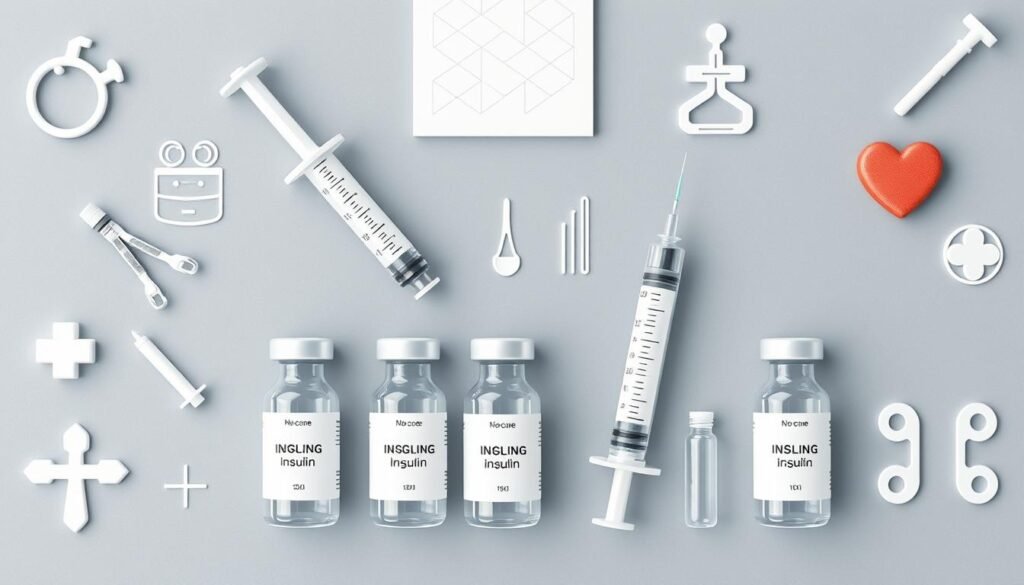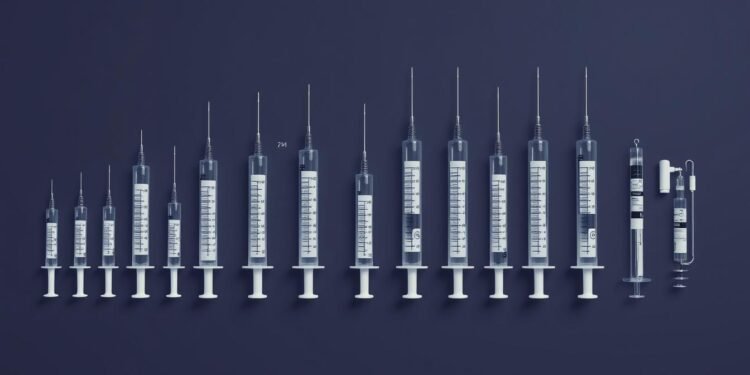Learning about SLIN (Sliding Scale Insulin) dosage is key for those new to insulin. It’s very important for people with type 2 diabetes. This SLIN dosage guide for beginners teaches the basics of insulin use. It shows how to keep insulin sensitivity by using the right dose and checking levels often.
Insulin is a hormone that helps control blood sugar. There are different types, like long-acting and rapid-acting. For new users, finding the right dose is very important. It helps avoid problems like low blood sugar. The right dose helps control sugar and keeps you healthy.
A study in 2015 showed that sliding scale insulin doesn’t help much. It can even cause high blood sugar more often. In 2012, another study found that it can lead to bad control and unpredictable low blood sugar. So, it’s very important for new patients to understand SLIN dosage well.
Key Takeaways
- SLIN therapy is vital for managing blood sugar levels in type 2 diabetes.
- Understanding the different types of insulin and their functions is important.
- Accurate dosing and regular monitoring help prevent hypoglycemia and hyperglycemia.
- Avoiding sliding scale insulin models is recommended due to their inflexibility.
- Starting dosages should be carefully calculated based on individual needs.
- Long-acting insulin is often administered once or twice a day.
- Real-time adjustments are necessary for effective intensive insulin therapy.
Understanding SLIN and Its Benefits
If you’re new to insulin, this beginner’s guide to SLIN usage is for you. SLIN, or synthetic insulin, is key for diabetes management. It helps the body use glucose well, keeping blood sugar levels healthy.
What is SLIN?
SLIN, also called insulin, is a hormone made by the pancreas. It helps cells take glucose from the blood for energy. There are different insulin strengths, like U-100 in the U.S. and U-500 for those with high insulin resistance. Knowing the types is key to using insulin right.
- Rapid-Acting Insulin: Starts working in 5 to 15 minutes, peaks in 1 to 2 hours, and lasts 4 to 6 hours.
- Regular or Short-Acting Insulin: Works in 30 minutes to 1 hour, peaks in 2 to 4 hours, and lasts 4 hours.
- Intermediate-Acting Insulin: Takes 2 to 4 hours to start, peaks in 4 to 12 hours, and lasts 12 to 18 hours.
- Long-Acting Insulin: Takes hours to start, and can last up to 24 hours.
- Ultra Long-Acting Insulin: Starts in about 6 hours and lasts 36 hours or more.
How Does SLIN Work?
SLIN mimics natural insulin production, helping control blood sugar. When someone with diabetes takes SLIN, it helps turn glucose into energy or glycogen. This is key to avoiding blood sugar spikes. Using an insulin injection guide helps get the dosage right.
Why Beginners Choose SLIN
Choosing SLIN might seem hard for beginners, but it has many benefits for diabetes management. The main reasons include:
- Improved Blood Sugar Control: Regular SLIN use keeps blood sugar stable, lowering the risk of low or high blood sugar.
- Prevention of Diabetes Complications: Proper insulin use prevents long-term diabetes problems like nerve damage, eye issues, and heart disease.
- Personalized Treatment Plans: With many insulin types, treatment can be customized to fit individual needs and lifestyle.
| Type of Insulin | Onset | Peak | Duration |
|---|---|---|---|
| Rapid-Acting | 5-15 mins | 1-2 hours | 4-6 hours |
| Short-Acting | 30 mins-1 hour | 2-4 hours | 4 hours |
| Intermediate-Acting | 2-4 hours | 4-12 hours | 12-18 hours |
| Long-Acting | Several hours | None | Up to 24 hours |
| Ultra Long-Acting | 6 hours | None | 36+ hours |
Importance of Proper Dosage
Taking the right amount of SLIN, or insulin, is key to keeping blood sugar levels healthy. It’s important for both Type 1 and Type 2 diabetes patients to know how to calculate their insulin dose. Taking too little or too much insulin can be dangerous.
The Risks of Incorrect Dosage
Taking too little insulin can cause blood sugar to drop too low. This is called hypoglycemia. Symptoms include sweating, shaking, feeling confused, and a fast heartbeat. If it gets too bad, you might lose consciousness and need glucagon right away.
On the other hand, taking too much insulin can make blood sugar go up too high. This can cause problems over time.
Benefits of Accurate Dosing
Taking the right amount of insulin keeps blood sugar stable. This helps avoid serious problems like heart, kidney, and nerve damage. The American Diabetes Association says finding the right insulin dose is a process of trial and error.
Using detailed *insulin dosing charts* helps. These charts help patients adjust their doses based on diet, exercise, and stress.
Common Mistakes to Avoid
Some common mistakes include not thinking about when you eat, using the wrong syringe, and mixing insulins wrong. For example, rapid and short-acting insulins should be taken 10 to 15 minutes before meals. Long-acting insulins keep blood sugar stable all day.
Also, make sure to use clear and colorless short-acting insulin for it to work right.
| Insulin Type | Duration | Peak Time (if applicable) |
|---|---|---|
| Degludec | Up to 42 hours | N/A |
| Detemir | 18-24 hours | N/A |
| Glargine | Up to 24 hours | N/A |
| Rapid-acting Insulin | 3-5 hours | 1-3 hours |
| Short-acting Insulin | 5-8 hours | 2-4 hours |
Recommended Starting Dosages for Beginners
Finding the right insulin dose is hard but key for managing blood sugar. Here are some insulin beginner dosing tips to help you.
Standard Dosage Guidelines
Most beginners start with 10 units of basal insulin. If you’re thin or have slightly high fasting sugar, start with 0.1 units per kilogram of body weight per day. Then, increase by 2 units every 2-3 days until your fasting sugar is under 130 mg/dL.
| Fasting Glucose Level (mg/dL) | Adjustment |
|---|---|
| > 200 | Increase by 4 units |
| 131-200 | Increase by 2 units |
| 70-130 | No change |
| < 70 | Decrease by 2-4 units or by 10% |

Tailoring Dosage to Individual Needs
Everyone’s body reacts differently to insulin. It’s important to adjust doses based on your body, diet, and health. For example, the carb to insulin ratio might need tweaking based on how you digest carbs.
Watch your meal times, pre-meal, and post-meal sugar levels. This helps adjust your insulin injection techniques for beginners. Start with 6-10 units of prandial insulin and adjust based on your basal dose and carbs.
It’s also key to avoid low blood sugar. Watch for symptoms and use the correction factor method for safe dose changes. This helps you reach your sugar goals with confidence.
Timing Your SLIN Doses
Knowing when to take SLIN is key to getting the most out of it. This part talks about the best times for insulin shots. It also shares tips to make your insulin work better and avoid problems.
When to Take SLIN
Long-acting insulin is usually taken once or twice a day. If you take it once a day, do it at the same time every day. For twice a day, space your doses 12 hours apart. This keeps your insulin levels steady and stops your blood sugar from going up and down.
Effects of Meal Timing
When you eat affects how well your insulin works. Regular insulin is best taken 30 minutes before a meal. This helps control your blood sugar after eating. Rapid-acting insulin works fast, so take it right before or after a meal. These tips help keep your blood sugar from getting too high after eating.
Combining SLIN with Other Supplements
Mixing SLIN with other things needs careful watching. If you have type 2 diabetes, you might start with pills and add SLIN later. Be careful with supplements like chromium or berberine that affect blood sugar. Always talk to your doctor before adding new things to your routine. They can give you advice that fits your health needs.
| Insulin Type | Optimal Timing | Administration Tips |
|---|---|---|
| Long-acting | Once or twice a day; same time each day/12 hours apart | Monitor blood glucose levels regularly to avoid hypo-/hyperglycemia |
| Regular | 30 minutes before meals | Ensures proper management of post-meal blood glucose levels |
| Rapid-acting | Immediately before or after meals | Effective for quick blood sugar control around meal times |
Using these tips can help you figure out the best times for your SLIN shots. This can improve how you manage your blood sugar and your overall health.
Monitoring Your Progress with SLIN
It’s important to watch your SLIN dosage closely. This helps keep your blood sugar in check and keeps you healthy. An insulin injection guide can help you see how you’re doing and change your doses if needed.
How to Track Your Results
Keep an eye on your blood sugar levels with a meter or a continuous glucose monitor (CGM). People with type 1 diabetes should test their blood sugar 4 to 10 times a day. Those with type 2 diabetes using insulin might need to test more often, before meals and at night.
- Pre-meal blood glucose levels: Target 80 to 130 mg/dL
- Blood glucose levels 2 hours post-meal: Less than 180 mg/dL
- Goal for A1C levels: Below 7%
CGMs let you check your levels often. Some need a new sensor every 10 days to six months. Make sure to write down your test results, including the date, time, and what you did that day.
Signs of Proper Dosage
Knowing if your SLIN dosage is right means watching how your body reacts. Good signs include steady blood sugar levels, more energy, and fewer diabetes symptoms. Also, doing 150 minutes of exercise a week and A1C levels under 7% show you’re on the right path.
Adjusting Dosage Based on Feedback
Change your SLIN dosage based on what your tests show. If your blood sugar is often too high or too low, talk to your doctor about changing your doses. An insulin injection guide can help you understand how to make these changes.
| Metric | Recommended Range |
|---|---|
| Pre-meal Blood Glucose | 80 to 130 mg/dL |
| 2 Hours Post-meal Blood Glucose | Less than 180 mg/dL |
| A1C Levels | Below 7% |
| Blood Pressure | Below 130/80 mm Hg |
By using what you learn from monitoring and measuring your SLIN doses carefully, you keep your insulin working well. This helps you stay healthy and happy.
Potential Side Effects of SLIN
Over 30 million people in the U.S. have diabetes. Many use SLIN (insulin) to treat it. This section talks about side effects and how to manage them.
Common Side Effects
Knowing about common side effects helps users of SLIN:
- Weight Gain: You might gain weight at first as your cells take in more glucose.
- Swelling: Fluid buildup can cause swelling, more so with certain combinations like insulin lispro with pioglitazone.
- Hypoglycemia: This is a big risk, causing symptoms like dizziness, confusion, and even loss of consciousness.
- Injection Site Reactions: You might get allergic reactions or fat necrosis, leading to painful lumps.
- Hyperglycemia: High blood sugar can happen if you don’t take enough insulin or miss doses.
- High Risk of Complications: Using SLIN can increase your risk of certain cancers and death, more than other treatments like metformin.

How to Manage Side Effects
Managing insulin side effects is key for a good treatment experience. Here are some tips:
- Regular Monitoring: See your doctor often for check-ups and to adjust your treatment as needed.
- Diet and Exercise: Changing your diet and exercise can affect how much insulin you need. Talk to your doctor about what’s best for you.
- Proper Injection Techniques: Change where you inject to avoid fat necrosis and other reactions.
- Emergency Preparedness: Always have a glucagon kit ready for severe low blood sugar episodes.
- Communication: Tell your family about side effects and what to do in emergencies.
Look at the table below for more info on SLIN types and how they work. It helps you manage side effects better:
| Type of Insulin | Onset | Duration | Common Uses |
|---|---|---|---|
| Rapid-Acting | 15 minutes | 3–5 hours | Meals |
| Short-Acting | 30–60 minutes | 5–8 hours | Meals |
| Intermediate-Acting | 1–3 hours | 12–16 hours | Basal |
| Long-Acting | 1 hour | 20–26 hours | Basal |
By being informed and proactive, you can get the most out of your SLIN therapy. This helps you live better with diabetes.
Combining SLIN with Diet and Exercise
Using SLIN with a good diet and exercise is key. It helps a lot with insulin sensitivity and blood sugar control.
Nutritional Considerations
When using SLIN, it’s important to watch what you eat. Stay away from foods like white bread and sugary snacks. Instead, eat whole grains, lean proteins, and healthy fats.
These foods help keep your blood sugar stable. They also make SLIN work better.
It’s good to eat every three to four hours. This helps your muscles recover and gives you energy. If your blood sugar is low, eating 15 to 30 grams of carbs before working out is a good idea.
Also, when you eat can affect how well SLIN works. Wait about three to four hours after eating to exercise. This helps burn more fat.
Best Exercises to Pair with SLIN
Exercise is very important for better insulin sensitivity. Activities like walking or cycling are good. They lower risks of heart disease and death in people with diabetes.
High-Intensity Interval Training (HIIT) is also great. It makes muscles better at using glucose and helps control blood sugar in adults with type 2 diabetes. Don’t forget to do resistance training 2 to 3 times a week. It helps get stronger and healthier.
Here’s a quick look at the benefits of different exercises:
| Exercise Type | Benefits |
|---|---|
| Aerobic Exercise | Increases muscle glucose uptake, lowers cardiovascular risks, improves insulin sensitivity, reduces A1C levels, and decreases triglycerides and blood pressure. |
| HIIT | Enhances skeletal muscle oxidative capacity, enhances glycemic control, and improves insulin sensitivity. |
| Resistance Training | Improves strength, body composition, cardiorespiratory fitness, and reduces falls risk by 28%−29%. |
Remember, how much insulin you need changes with the type, length, and intensity of your workout. Always talk to your doctor about your SLIN doses. With the right diet and exercise, SLIN can greatly improve your health and lifestyle.
Safety Precautions with SLIN Usage
When using SLIN, it’s very important to follow strict rules. These rules help keep you and others safe.
Guidelines for Safe Use
The FDA says all fingerstick devices should be for one person only. This stops germs from spreading. Insulin pens should also be used by just one person to avoid getting sick.
Using the same device for blood tests can lead to serious diseases. So, always wash your hands after taking off gloves. Also, check your blood sugar often and clean your hands after checking.
- Store insulin properly: Keep insulin at room temperature. Don’t freeze it or leave it in hot places. Once opened, a vial can stay at room temperature for 28 days.
- Administer carefully: Make sure injections are far from scars and the navel. Avoid areas that are bruised or swollen.
- Monitor injection sites: Change where you inject insulin to avoid lumps. About 30% of people get lumps if they use the same spot too much.
- Dispose of needles safely: Most people don’t use special containers for needles. Always throw them away safely.
- Priming procedures: Always prime your pen before using it. This helps you get the right dose. About 25% of people forget to do this.
| Precaution | Description |
|---|---|
| Changing gloves between patients | Change gloves after touching each patient. This stops germs from spreading. |
| Hand hygiene post-glove removal | Wash your hands right after taking off gloves. This helps prevent germs from spreading. |
| Monitoring infection control | Watch and check if people are following infection control rules. This keeps everyone safe. |
| Single-use devices | Use devices meant for one person only in places where help is needed. |
| Dedicated insulin vials | Use one insulin vial for one person whenever you can. This helps avoid mixing up doses. |
Who Should Avoid SLIN
Some people should not use SLIN. If you’re allergic to insulin or its parts, don’t use it. Also, if you’ve had severe reactions to it before, stay away.
Using SLIN safely is key. It helps avoid serious infections and keeps you healthy.
Advanced SLIN Techniques
For those who know a lot about SLIN therapy, there are special ways to use insulin. These include pulse dosing and cycling. They help control blood sugar better and lessen side effects.
Pulse Dosing Strategy
Pulse dosing means giving insulin in small amounts often. It’s like how our body naturally makes insulin. This helps keep blood sugar steady.
It can also lower the chance of getting too low blood sugar. This is good for those who use insulin.
Pulse dosing is great for dealing with high blood sugar after eating. Instead of one big dose, you might take smaller doses. This helps match the body’s natural insulin release better.
For example, you might take 2 units every 30 minutes for two hours before a big meal. This helps manage blood sugar spikes better than one big dose.
Cycling SLIN for Optimal Results
Cycling SLIN means switching between using a lot of insulin and using less or none. It helps avoid long-term problems and keeps the body responsive to insulin. This keeps insulin working well over time.
A common cycle is using more insulin for a few weeks, then less. During the high-dose time, you follow a plan for your insulin. This keeps your blood sugar in check:
| Phase | Duration | Insulin Dose |
|---|---|---|
| High-Dose | 3-4 weeks | Increased as per individual needs, closely monitored |
| Low-Dose | 1-2 weeks | Reduced to minimum effective dose |
In the low-dose phase, blood sugar might go up a bit. But it’s to make the body respond to insulin again. This method is very good for managing blood sugar over the long term.
Resources for Further Exploration
Learning more about SLIN (insulin) can help you manage diabetes better. Here are some great resources to help you learn and get support.
Recommended Reading Materials
Reading books by experts is key to understanding SLIN. “Think Like a Pancreas” by Gary Scheiner is a great start. It talks about insulin therapy in detail.
“Dr. Bernstein’s Diabetes Solution” by Richard K. Bernstein is also a must-read. It gives you tips on controlling blood sugar. Both books are filled with scientific facts to help you understand insulin better.
Online Forums and Support Groups
Online groups are great for learning and feeling supported. Sites like TuDiabetes and Diabetes Daily are perfect for connecting with others. You can share your stories and get tips from others.
These groups are full of helpful information. Plus, the American Diabetes Association has tools and webinars to keep you updated.
It’s important to know about new ways to use insulin. This helps you make smart choices for your treatment. It keeps you safe and informed.










